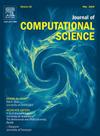Deep Link Strength Prediction: Leveraging line graph transformations and neural networks
IF 3.7
3区 计算机科学
Q2 COMPUTER SCIENCE, INTERDISCIPLINARY APPLICATIONS
引用次数: 0
Abstract
Predicting link strengths in complex networks is a fundamental challenge, crucial for understanding network dynamics and optimizing real-world applications. Traditional approaches often rely on shallow structural features, limiting their ability to model intricate dependencies. To address these limitations, we propose Deep Link Strength Prediction (DLSP), a novel framework that integrates line graph transformations with graph convolutional networks (GCNs) to enhance the predictive capability of link weight estimation. DLSP redefines the task by transforming edge-centric information into node-level representations, facilitating effective learning of complex structural patterns. DLSP follows a multi-phase approach: first, a localized subgraph around the target link is extracted and encoded using a weighted node labeling scheme, preserving local structural and attribute-driven properties. Next, the labeled subgraph undergoes a line graph transformation, mapping link dependencies into node representations, thereby enabling a structured embedding space. A GCN is then employed to extract rich hierarchical representations, capturing both micro and macro-level graph structures. Finally, these learned embeddings are passed through a dense neural network to estimate the target link strength, framing the problem as a continuous-valued regression task. Unlike existing methods that rely on handcrafted features or isolated node embeddings, DLSP explicitly models link dependencies through graph-aware transformations, leading to superior predictive performance. Extensive experiments conducted on six diverse network datasets demonstrate that DLSP consistently outperforms state-of-the-art methods, showcasing its robustness, scalability, and potential for real-world applications.
深度链接强度预测:利用线图转换和神经网络
预测复杂网络中的链路强度是一项基本挑战,对于理解网络动态和优化实际应用至关重要。传统方法通常依赖于浅层结构特征,限制了它们对复杂依赖关系建模的能力。为了解决这些限制,我们提出了深度链路强度预测(DLSP),这是一种将线形图变换与图卷积网络(GCNs)相结合的新框架,以增强链路权重估计的预测能力。dllsp通过将以边缘为中心的信息转换为节点级表示来重新定义任务,从而促进对复杂结构模式的有效学习。dlp采用多阶段方法:首先,使用加权节点标记方案提取目标链路周围的局部子图并对其进行编码,保留局部结构和属性驱动属性。接下来,标记的子图进行线形图转换,将链接依赖关系映射到节点表示,从而实现结构化嵌入空间。然后使用GCN提取丰富的层次表示,捕获微观和宏观级别的图结构。最后,这些学习到的嵌入通过一个密集的神经网络来估计目标链路的强度,将问题作为一个连续值回归任务。与现有依赖手工特征或孤立节点嵌入的方法不同,dlp通过图形感知转换显式地对链接依赖关系建模,从而获得卓越的预测性能。在六个不同的网络数据集上进行的广泛实验表明,dllsp始终优于最先进的方法,展示了其鲁棒性、可扩展性和现实应用的潜力。
本文章由计算机程序翻译,如有差异,请以英文原文为准。
求助全文
约1分钟内获得全文
求助全文
来源期刊

Journal of Computational Science
COMPUTER SCIENCE, INTERDISCIPLINARY APPLICATIONS-COMPUTER SCIENCE, THEORY & METHODS
CiteScore
5.50
自引率
3.00%
发文量
227
审稿时长
41 days
期刊介绍:
Computational Science is a rapidly growing multi- and interdisciplinary field that uses advanced computing and data analysis to understand and solve complex problems. It has reached a level of predictive capability that now firmly complements the traditional pillars of experimentation and theory.
The recent advances in experimental techniques such as detectors, on-line sensor networks and high-resolution imaging techniques, have opened up new windows into physical and biological processes at many levels of detail. The resulting data explosion allows for detailed data driven modeling and simulation.
This new discipline in science combines computational thinking, modern computational methods, devices and collateral technologies to address problems far beyond the scope of traditional numerical methods.
Computational science typically unifies three distinct elements:
• Modeling, Algorithms and Simulations (e.g. numerical and non-numerical, discrete and continuous);
• Software developed to solve science (e.g., biological, physical, and social), engineering, medicine, and humanities problems;
• Computer and information science that develops and optimizes the advanced system hardware, software, networking, and data management components (e.g. problem solving environments).
 求助内容:
求助内容: 应助结果提醒方式:
应助结果提醒方式:


